The procedure for removing the battery from the car. Removal - installation of the battery
The need to dismantle the battery can arise for various reasons. Although for many car owners the process of removing the battery is to disconnect the contacts and remove the device, in fact, you need to look deeper. Read more about how to remove the battery from the car yourself, read below.
What you need to know before removing the battery?
Before disconnecting the car battery, first of all, you need to read the service manual. Some cars today are equipped with a special shield to turn off the mass on the car body. You can also find cars equipped with a special toggle switch. Therefore, before removing the battery from the car, you need to familiarize yourself with the capabilities of the vehicle.
There are cars on which the battery cannot be disconnected. In parallel, another battery is connected and a replacement is made!
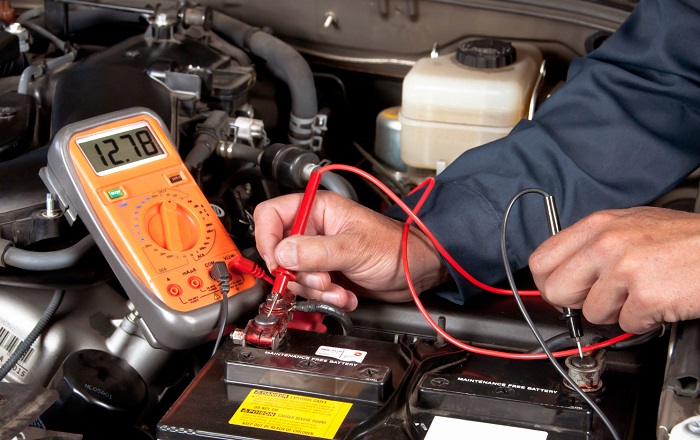
To prevent a spark from slipping, some motorists install an additional fuse on the car, mounted on the negative battery outlet. The battery as a whole must be handled with care. If the device falls, the seal may break, and the electrolyte may leak through the crack.
Precautions and safety
If you decide to disconnect the car battery, it will be useful for you to know what absolutely cannot be done with the device:
- throw the battery on the ground or allow it to fall on the vehicle components.
- turn the device over - this will lead to the fact that the electrolyte will clog the ventilation lines of the structure;
- by force, act on the terminals of the device, trying to put them on the conclusions by force;
- completely drain the electrolyte from the system, which will lead to sediments floating up from the bottom and, again, clogging their holes;
- act with force on the device, trying to dismantle or install it;
- store discharged batteries, in particular, outdoors at sub-zero temperatures;
- add electrolyte or some kind of acid to the device - only distillate is allowed.
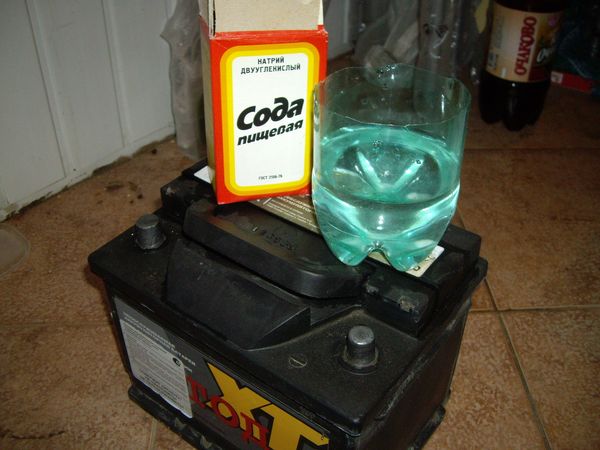
To complete the dismantling task, you will only need two wrenches with the appropriate sizes. Also, prepare a rag or brush to clean the battery. If electrolyte is accidentally spilled during the process, you will need a reaction activator neutralizer.
If you are using an acid battery in your car, prepare an alkali for the task, such as a baking soda solution or a 10% alcohol solution. Alkaline batteries require a weak acid solution. Dismantling is best done on the street or in a ventilated area.
Battery removal guide
How to properly remove the battery in a car:
- Open the hood and loosen the negative with a wrench. Disconnect it completely. If there is an insulator, loosen it.
- Remove the positive terminal.
- Unscrew the nuts and straps that secure the battery at the installation site.
- Dismantle the battery.
Further installation is carried out in the reverse order. If the battery is protected by a decorative casing, it must also be removed (video by sxemotehnika).
Preventive actions
To begin with, the design of the device should be cleaned. Check if the plugs are tightly screwed on. To neutralize the precipitated electrolyte, the cover should be wiped, for this a solution of baking soda is used, which is subsequently washed off with water. Wipe the device dry with a cloth. Similarly, it is necessary to wipe all other structural elements - fixation plates, mounting holes, plugs, etc.
Next, you need to clean the ventilation holes, experts recommend performing this procedure at least once a month. In addition, it is necessary to clean the battery seat as well - as practice shows, dust and dirt often collect here. If the battery is located near the exhaust manifold, it must be protected from it using any metal screen. And in winter time a year, the flow from the radiator should heat the device, which will save its charge.
After dismantling the device, it is necessary to measure its voltage. It will not be superfluous to check how much electrolyte is in the structure. If there is too little electrolyte, water can be added. As for directly charging the battery, we have already written about this in detail.
Features of the process of removing a car battery
There are a few things to consider when removing the battery:
- The dismantling procedure is carried out only with the engine turned off. If you try to disconnect the battery while the engine is running, this can cause a power surge, and therefore, electrical appliances can simply fail. Since the voltage can increase several times, the anti-theft system will fail first of all, and the on-board computer settings will simply go wrong. These are just a few of the problems you will face.
- Always follow the terminal disconnection sequence. The minus is always turned off first, since it is connected to the car body. Any element connected to the minus can cause a short circuit in case of non-compliance with the actions.
In winter, accompanied severe frosts, it is highly recommended to remove the battery from the vehicle and take it to a warm place (such as a heated garage) so that the car starts easily the next day. Not every motorist can name the correct sequence of actions and the basic rules for performing this simple job. The purpose of this article is to figure out how to remove the battery from the car?
Preparation
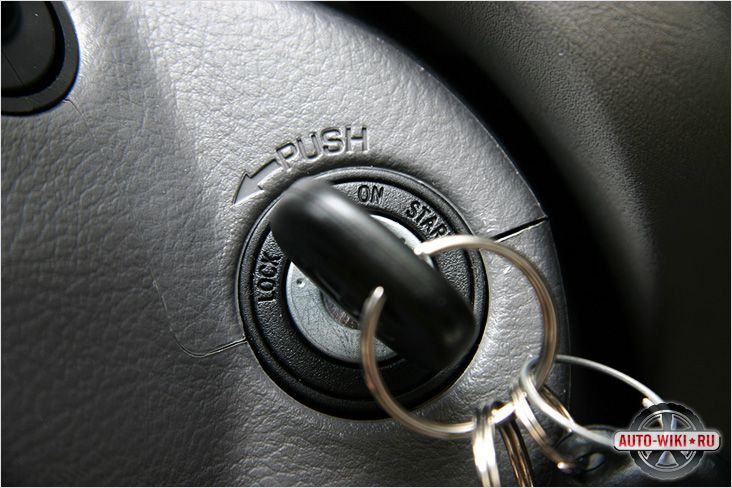
Withdrawal car battery must be preceded by the following:
- First you need to turn off the ignition and all interior devices: interior lighting, headlights, air conditioning, radio, etc., and also make sure that all doors and windows are locked.
- Now you can pull out the ignition key. At the same time, you need to remember that many modern cars have automatic door locking, therefore, the key must be at hand.
Most battery manufacturers describe the dismantling process in the passport. Some cars have a shield so that you can turn off the ground on the body. And in foreign cars equipped with an on-board computer, there is a toggle switch needed to turn off the battery in case of unforeseen circumstances.
When the battery is disconnected, sparks can jump, which can be protected from with the help of a special device - a fuse installed on the negative wire.
The battery does not tolerate rough handling. Doing so may cause the batteries to leak and leak electrolyte, causing the instrument to malfunction.
Removing the battery
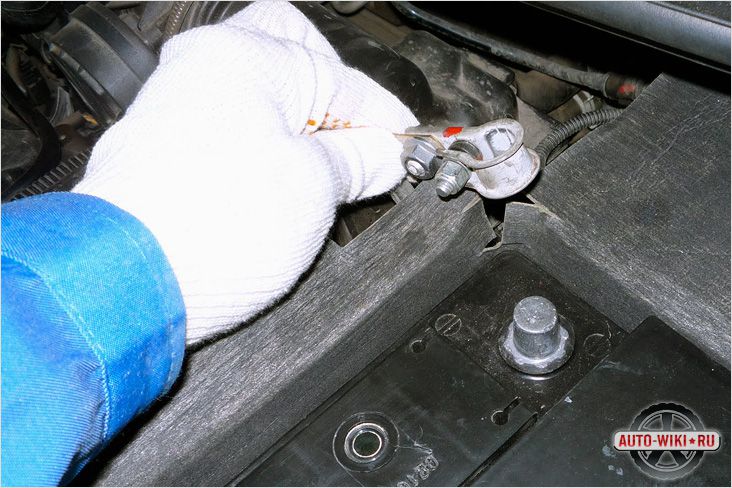
The battery removal procedure involves the following:
- Correct terminal removal: first negative, then positive. This sequence is mandatory for both injection and carbureted engines. If you do not follow this recommendation, the following situation may arise: the removed "plus" will touch some metal element and lead to a short circuit or even ignition.
- The battery fastening nuts should be carefully unscrewed. The battery must be removed with the utmost care. A slight impact may cause electrolyte leakage, which is harmful to the device and dangerous to human health.
The presence of sparks during operation indicates that there are appliances left in the car.
Safety
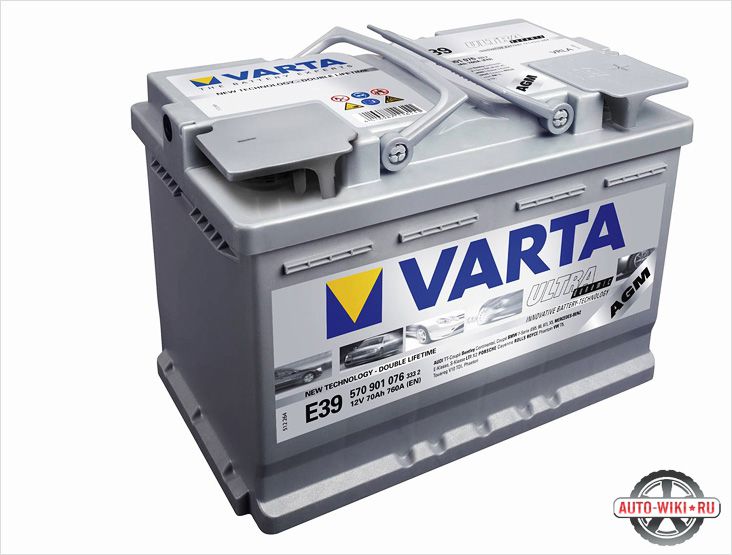
During the operation of the battery and the implementation of any manipulations with it, it is prohibited:
- various kinds of mechanical damage to the case;
- turning over (electrolyte may clog vents);
- forced installation of terminals on pins;
- draining the electrolyte (the sediment floating up from the bottom can lead to clogging of the holes);
- storage of discharged batteries, especially in the cold;
- adding electrolyte or acids (only distilled water can be used).
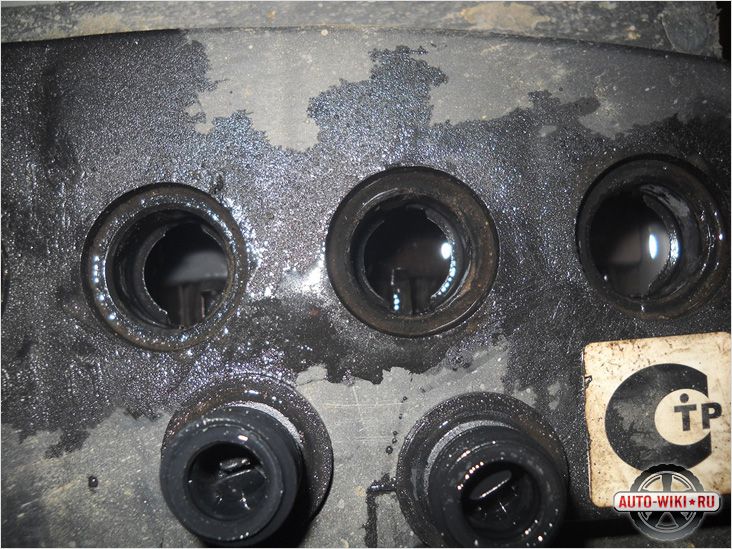
It is necessary to provide for their actions in case an electrolyte leak occurs. In the case of using an acid device, you need to take care of the presence of alkali (soda or 10% ammonia solution). And for an alkaline battery, it is necessary to prepare an acid solution of low concentration.
Any place (car surface or skin) where a trace of electrolyte is found should be treated with the appropriate composition. Use goggles to protect your eyes, and thick rubber gloves to protect your hands. The rest of the body should be hidden under clothing.
It is best to work outdoors or in a well-ventilated garage with adequate lighting.
Prevention
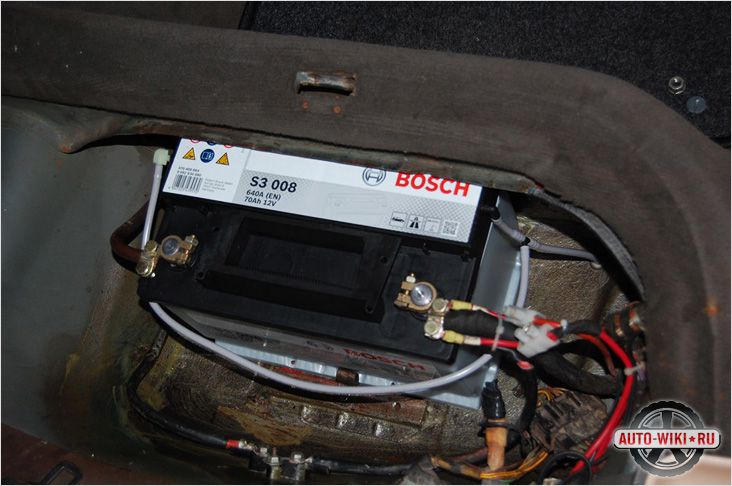
Periodic battery maintenance should include the following:
- Checking the tightness of the screw caps in the removed batteries. To neutralize the precipitated electrolyte, you will need baking soda, water and rags. The cleaning procedure should be subjected to the cover, plates, holes for fasteners, strips and plugs.
- Cleaning holes for ventilation. The gas outlet is usually built into the middle cells. Batteries require special attention, in which special compartments are designed to accommodate batteries. In these places, dust, dirt and precipitated electrolyte most often accumulate. The cleaning process is especially necessary in hot weather, otherwise there is a danger that the electrolyte will evaporate and the sulfation process will begin on the plates.
- In winter, you need to direct the heat coming from the radiator to the battery. This will help maintain optimal charge.
Video
How to change the battery, see the following video:
A car battery has a certain lifespan, but in order for it to last longer, it needs to be serviced periodically. Therefore, almost every car owner is faced with the need to remove the battery from the car, and it does not matter globally whether the car is old or new. Correctly removing the battery is very important, incorrect actions in such a case often lead to very sad consequences. Both the battery and the car itself can suffer from negligence and mistakes, especially if a short circuit occurs as a result of careless handling.
Exist general rules battery dismantling, which all experienced motorists adhere to, but also some car models have specific features, for example, a non-standard location of the battery capacity, the presence of additional protection of its body from damage. And, of course, you should follow the safety rules, every driver should know them.
How to remove the battery from the car
The battery plays a big role in the composition of the car, if it does not have enough capacity and cannot start the engine, the car will not go anywhere. Also, the charge should be enough for the operation of various consumers:
- interior and exterior lighting;
- heater and wiper motors;
- air conditioning system;
- audio systems;
- cigarette lighter and more.
Batteries are maintenance-free and serviced, but even if the passport data indicates that the source of electricity does not require topping up the electrolyte, this does not mean that it does not need to be looked after. The battery is most often removed for recharging and prevention (cleaning from dirt and debris), dismantling is also required:
- when placing a car for a long parking;
- during major work (engine repair, body painting, etc.);
- if the battery interferes with getting to the car hub;
- for recharging the battery (optional, but desirable);
- to replace the battery.
There are certain conditions for dismantling, and they must be met, the most basic of them:
- the engine of the car must be turned off and the ignition turned off;
- before removing the battery terminals, all consumers are turned off;
- first of all, the mass terminal (“minus”) is always disconnected;
- you need to remove the battery only after it is completely freed from the mounting plates;
- hold the battery firmly - when it falls, the battery case is damaged, and then the energy storage device becomes unusable;
- when removing the battery, it must not be turned over, and it should be placed on a horizontal, flat surface - otherwise the electrolyte may leak out, and in general, the plugs of the battery cans should always be directed only upwards;
- terminal connections must be unscrewed thoroughly, when pulling the wires, you cannot use great effort, if you work carelessly, you can easily damage the terminals;
- dismantling is highly desirable to be done in the open air, and if in a garage, then with open doors;
- it is highly recommended to work with the battery with gloves, electrolyte or oxide should not get on open parts of the body.
Correctly removing the battery from the car as a whole is not difficult, you just need to fulfill the above conditions, take your time, take care of your car and yourself.
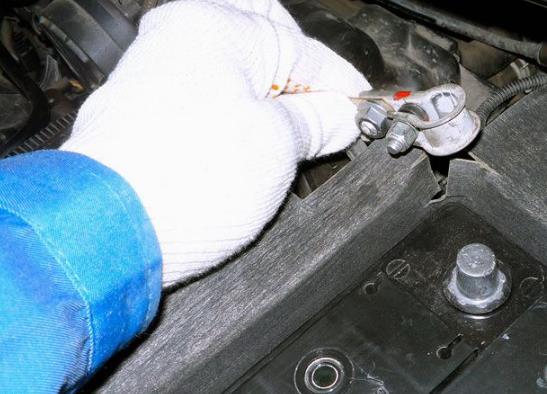
Why you need to disconnect the ground terminal first
There is a certain procedure for dismantling the terminal wires for a reason; it is much safer to remove the terminals from the battery, starting from the minus. Here you need to remember that in a modern car, the “minus” is the body itself. If the "+" terminal is first disconnected, and the "-" terminal is left in place, a metal object caught between the body and the positive terminal will cause a short circuit, since the mass is not disconnected at this moment. When the negative plate of the battery does not have an electrical connection with the body of the car, nothing criminal can happen, there will be no short circuit.
Rules for removing the battery on a car with an alarm
Some security systems have their own specifics, therefore,
when removing the battery on a car with an alarm, this must be taken into account. After turning off the power, various kinds of failures may occur, for example, the program will change, it may be necessary to re-program the “signaling”.
On some security systems, after disconnecting the terminals, a siren is triggered, and before removing the battery, the “bell” must be turned off. Even when the terminal wires are disconnected, the alarm can block the doors, so you must not forget the keys in the cabin.
Procedure for removing the battery
Dismantling the battery is usually performed in the following order:
- turn off the engine;
- we turn off all consumers of electricity - headlights, radio, dimensions, etc.;
- we take the keys from the car with us, do not leave them in the cabin;
- we find the battery (most often it is located under the hood, but it can be in other places - in the cabin under the passenger or driver seat, in the trunk);
- dismantle the protective covers covering the battery (if any);
- unscrewing the bolt with a nut, remove the mass terminal (you will need keys for 13 or 10, depending on the type of battery). Before disconnecting, the terminal must first be swung against and clockwise;
- we perform the same actions with a positive wire;
- completely disconnect the battery mount, if the fastener is only loosened and try to remove the battery, the battery case can be damaged;
- if something interferes with the removal, these obstacles must be removed, and not try to pull out the battery in any way.
On many cars, when the terminals are disconnected, the settings of the on-board computer, audio center, etc. are lost. If you do not want to engage in system programming, you should connect a backup power source with a capacity of at least 4 A / h during the absence of the battery.
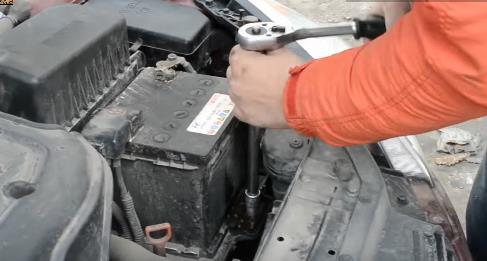
The installation of the energy storage device is carried out similarly to removal, but in the reverse order, and the following nuances must be taken into account here:
- before installation, the terminals and wires at the points of their connection must be absolutely clean and dry, the presence of oxidation products, dirt, oil, etc. is not allowed;
- the terminals must be firmly fixed in place, the nuts and bolts cannot be threaded, the terminals must be planted firmly, not dangling;
- you need to securely fasten the battery in its place, if this is not done, its case can easily be damaged during operation.
Some drivers mistakenly believe that lithol or other grease in the terminal connection prevents the appearance of oxide, promotes better contact. Such a statement is fundamentally wrong, and if you want to protect the battery terminals from the influence environment, then the lubricant must be applied over them, and in no case at the junctions.
Now the automotive industry produces various auto chemicals, there are also drugs designed to protect battery terminals (for example, technical petroleum jelly). Products are manufactured by companies such as Presto, Liqui Moly, often such compounds are painted in bright blue or red. Coloring is done on purpose, it determines where the protective layer is applied.
What not to do when removing the battery
It often happens that the battery sits down, the starter does not scroll the engine. Many car owners take a working battery from a neighbor, start the engine and rearrange the battery on a running internal combustion engine. This should not be done, although it may be lucky and nothing will happen, but quite often the owner of the car has various problems.
The thing is that while the engine is running, the generator generates electricity, not only gives energy to consumers, but also recharges the battery banks. At the moment of disconnecting the terminal, the load on the generator decreases, the voltage increases sharply. Accordingly, expensive electronics can fail from too much voltage - an engine control unit, an audio system, on-board computer etc. The settings of electronic systems may also change, for example, the alarm will start working differently.
If the terminals are oxidized
Oxidation at the terminal leads occurs:
- due to a leaky battery case;
- due to a faulty generator giving recharge.
The oxide is formed in the form of a whitish coating, similar to salt, it indicates that it is urgent to take some measures to eliminate this defect. If plaque has accumulated on the battery terminals, it will not be easy to remove the wires from them, and before unwinding the nuts and bolts, you must first remove the oxide that has formed.
The easiest way to clean the battery from plaque is with a solution of baking soda, it must be applied to the oxidized surface and wait for a while. After the build-up dissolves, its remnants will need to be thoroughly removed with a clean rag, and only after that it will be possible to proceed with the removal of the wires.
More important point– oxidized plaque accumulates on the inner surface of the battery wire terminals. It must be cleaned, otherwise contact is lost, the engine starts to start with problems, the wires heat up.
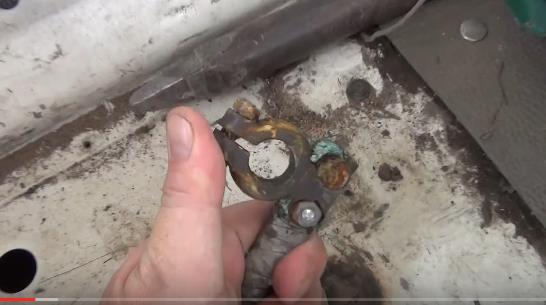
You can clean oxidized areas with:
- sandpaper;
- WD-40;
- ordinary water and rags.
By the way, with a rag, abundantly moistened with water, plaque is cleaned effectively, you just need not to spare the liquid, repeat the action several times. On the contrary, it is better not to use a metal brush - deep scratches form on soft metal, in which dirt accumulates, which makes contact worse.
Removing the BMW E53 battery (dorestyling)
On some machines, the battery is difficult to remove and requires a lot of work to remove it. The electric power storage device of the BMW crossover is located in the trunk, it is not at all easy to get to it. To remove the battery on a German SUV, you must:
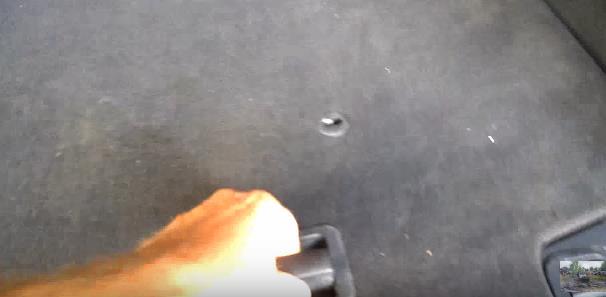
On technically complex vehicles with a large number of different electronics, trust the removal of the battery better for professionals, repairing expensive equipment will cost much more than replacing a battery.
A car battery is a battery that supplies electricity to a car. Traditionally referred to as SLI batteries, they are required for starting, lighting, ignition and to start the engine. As soon as the engine starts, the alternator supplies power to the vehicle. As a rule, starting the engine consumes less than three percent of the battery capacity. SLI batteries are designed to deliver a large surge of current, measured in amps, after which they can be quickly recharged. Such batteries are not designed to be discharged to a low level, and a full discharge can completely shorten their life.
Steps
- Switch off the ignition.
- Wear safety goggles and gloves to protect your eyes and hands.
-
Find the negative terminal on your battery. She usually has a black finish. Also, the battery may have a minus sign next to the negative terminal. Next to the positive terminal there will be a plus sign on the battery, the positive terminal usually has a red cap.
Determine what size bit you need to remove the nut from the negative terminal. Always start with the negative terminal when you disconnect the battery.
- Take the nozzle and place it on the nut next to the negative terminal (but not opposite the nut). Approximately estimate the size of the socket that you will need to loosen the nut.
- Put the cap on the key. You may need a wrench extension so that you can reach the nut with it.
- Place the wrench on the negative terminal nut and start turning it counterclockwise (to the right - tighten, to the left - loosen). It only takes a couple of turns of the wrench to loosen the nut.
- Pull on the negative wire as soon as you loosen it. Set it aside so that it does not touch the negative battery terminal while you work.
- If the cable is tightly attached to the battery post, you may need a special tool to remove the negative cable. Contact a mechanic or a specialized auto parts store.
-
Repeat the same procedure to disconnect the positive terminal. Once the positive terminal is disconnected, the positive wire must not touch any metal part of the machine. There is residual current in the circuit, which, if it comes into contact with a metal surface, can damage the electronics of the machine, or cause a short circuit.
-
Keep going. Once you disconnect the wires from the battery, you can start working on the electronics of the machine. If you just need to replace the old battery with a new one, it's easy enough to do.
- Once you turn off the power to the battery, you can detach the battery mount.
- Carefully lift the battery out of its compartment. Keep in mind that a car battery can weigh up to 20 kilograms, so you may need help.
- Using an old toothbrush, clean the battery compartment with a baking soda solution. Allow the compartment to dry before installing a new battery.
- Place the new battery in the compartment and tighten the fastener.
- Connect the positive terminal first, then the negative. Be sure to tighten the nuts on each of them tightly.
- Close the hood and start the car.
- Dispose of the old battery properly. The auto parts store where you purchased your new battery will most likely accept your old battery. If not, take it to a designated recycling center or auto service station. In most places, your battery can be purchased for a small price.
- Standard car batteries can generate several hundred amps, which is about the power of a welding machine. Do not try to check the charge on your battery by touching the positive and negative terminals with a metal tool. The current is so high that it can damage the tool and even harm your health.
- Place the wires away from the battery so that they do not accidentally return to their original position, causing a stream of electrical sparks.
- Remove all jewelry, especially rings and necklaces.
- Work outdoors so gases cannot accumulate.
- Wear protective gloves and goggles.
- Batteries in hybrid vehicles produce over 300 volts of power, which is a potentially lethal amount. If you need to work on the electronics of such a car, first of all, disconnect the battery, which is located at the back of the car. Wiring usually differs in colors. Use insulated tools and gloves while working to reduce the risk of electric shock.
Take the necessary precautions before disconnecting the battery. In addition to containing enough energy to kill a battery, it also contains corrosive substances that can produce flammable gas. Before removing the battery, do the following:
Every car enthusiast should know how to remove the battery terminals, even an inexperienced user. And if your car is this moment is “on a joke”, this does not mean that the battery terminals will remain perfectly clean until you decide to get behind the wheel again.
Vapors from the battery are still present, air circulates and contacts interact with inevitable pollution, and a whitish coating forms. So there is a high probability that, when you are going to go somewhere, you simply cannot start.
What is the reason: dead battery? Most likely not: you just need to clean the oxidized terminals, and the car will start again. It is also very important to carry out regular maintenance of the battery if you use the car every day (well, or, in any case, often). Moreover, even from school lessons in physics, everyone knows that good contact and conductivity are the key to the successful supply of electric current to all “powered” parts of your machine. And the purity and absence of oxidation on the terminals will greatly contribute to this.
How to remove the terminals from the battery is easy to remember, and even a child will cope with the process itself. The main thing in this matter is to be careful and follow the correct sequence of actions so that you do not get electrocuted. Moreover, electric shock is even the smallest problem: a spark, quite, can provoke a fire. Therefore, in addition to the rules of personal safety, fire safety must also be observed - do not lay oily rags around the battery, and even more so newspapers and paper.
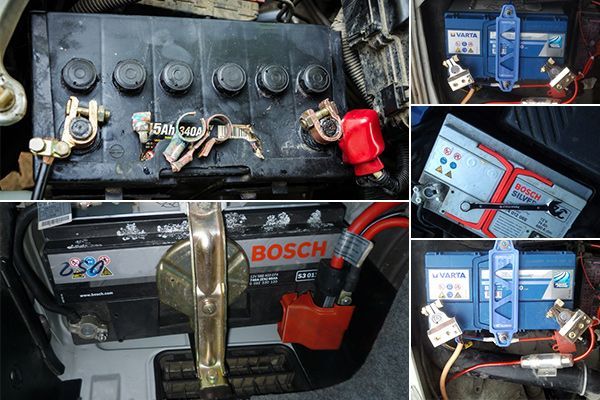
Sequencing
We lower introductory part regarding the search for a battery - I think if you have a car for more than a day, you already know where it is. If the battery is covered with a cover (factory or homemade), it must be removed. If the machine is grounded, the grounding is disconnected first. There is a lot of controversy around the sequence of disconnecting the terminals. What is removed first, plus or minus? Definitely minus! By disconnecting the negative terminal, you leave the "ground" without potential. So even accidentally touching the positive terminal will not cause a circuit.
Before turning off, if the “plus” is open (the “native” cover is lost), you need to wrap it with a rag or put on a plastic cap from a bottle of detergent - then it definitely won’t pull while you are fiddling with the “minus”.
The key loosens the nut on the "mass", after which the terminal is removed. If she managed to stick, she is slightly loosened with a wrench. Then the "plus" is released from the factory cover (or an impromptu shell) and removed. Although the negative terminal has already been removed, it’s still better to try not to touch the “plus” and something metal under the hood at the same time - as you know, an unloaded gun can shoot.
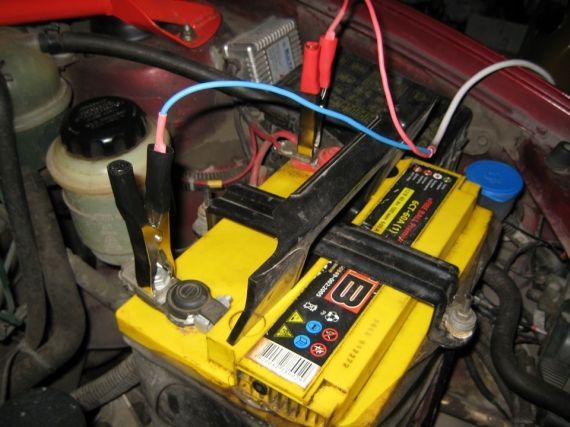
Treatment
In order for the contact of the terminals with the battery to be ideal, before returning them to their place, you need to strip the terminals. To do this, they fall asleep with ordinary baking soda. The same is done with the terminals. A special brush is taken - it is sold in any auto shop and costs a penny, and the thing is very useful in the household.
If you don't have one, definitely buy it. It looks like it consists of two parts: one with a hard “pile”, the second is narrow, crawling into any cracks.
Too lazy to buy such a useful tool - use an old toothbrush. True, her bristles are too soft, so it will take longer to mess around. With a brush, everything superfluous is removed from the terminals and leads, after which they are washed with distilled water - it is more convenient to use a spray bottle. You can, in principle, use ordinary water, but salts can form from it if you do not remove moisture well enough.
When the desired degree of purity is reached, all drops are wiped dry with a clean rag, and the terminals and leads are lubricated with an anti-corrosion agent. Which one is up to you to choose, but at least technical petroleum jelly should be put into action.
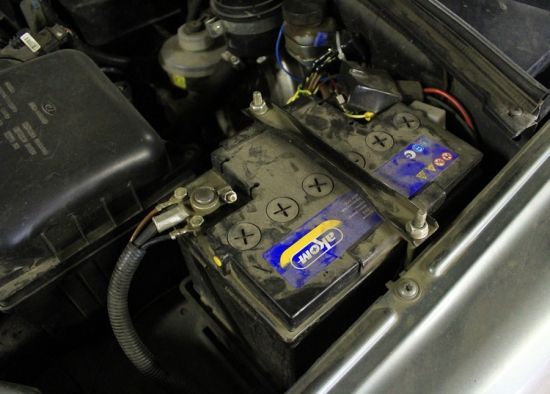
Reassembly
The stripped terminals are put on the leads in the reverse order - all for the same safety reasons. First, a “plus” is put on and baited with a nut. When her free move ends, she reaches out with a key. The main thing here is not to overdo it, so as not to break the thread. Then a protection is put on the terminal. When it is lost, most people wrap the terminal with a rag. In our opinion - not too reasonable, since the fabric is highly flammable. Therefore, it is better to cut off a strip of rubber and fix it with a piece of wire until you reach a place where you can buy a cover.
Then the negative terminal is put on and fixed - in the same way: until the end of the free play, the nut is screwed on by hand, then turned with a key. If there is a common protective cover, it is put in place, all tools are removed from the hood. The rag that you used is thrown away - it may be in the electrolyte.
Finally, we recommend that you carry out such a procedure more often, since removing the terminals from the battery and putting them back in place is not at all a protracted matter, but it can prevent very serious problems. Do not be lazy to look under the hood at least once a month.




